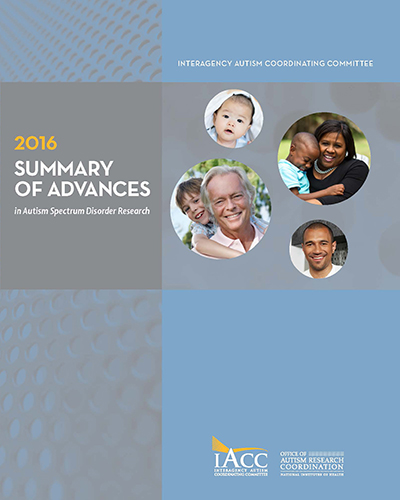Summary of Advances
In Autism Spectrum Disorder Research
2016
Prevalence and characteristics of autism spectrum disorder among children aged 8 years—Autism and Developmental Disabilities Monitoring Network, 11 sites, United States, 2012
Christensen DL, Baio J, Van Naarden Braun K, Bilder D, Charles J, Constantino JN, Daniels J, Durkin MS, Fitzgerald RT, Kurzius-Spencer M, Lee LC, Pettygrove S, Robinson C, Schulz E, Wells C, Wingate MS, Zahorodny W, Yeargin-Allsopp M. MMWR Surveill Summ. 2016 Apr 1;65(3):1-23. [PMID: 27031587]
Ongoing efforts to monitor the prevalence of ASD are important to substantiate the need for service and treatment programs, identify vulnerable populations, justify increased funding, and support new policies. The Autism and Developmental Disabilities Monitoring (ADDM) Network is a group of programs funded by the Centers for Disease Control and Prevention (CDC) to monitor the prevalence and characteristics of ASD in 8-year-old children (the age by which most children have been diagnosed). The ADDM Network tracks data from 11 communities in the United States that represent the diversity of children with ASD across the country. The ADDM Network recently published their 2012 report, which describes the number and characteristics of children with ASD, including the specific types of ASD diagnoses, the number of children with ASD who have intellectual disabilities based on standardized tests, and the frequency of early ASD diagnoses. To identify the population, the ADDM researchers first reviewed records to assess whether children had received education or healthcare services related to developmental disabilities. Then, clinical experts evaluated those records to determine if children met ASD diagnostic criteria. ASD criteria for this report was established using the fourth edition of the Diagnostic and Statistical Manual of Mental Disorders (DSM-IV-TR).
Across the ADDM Network in 2012, 5,063 children met DSM-IV-TR criteria for autistic disorder, pervasive developmental disorder–not otherwise specified (PDD-NOS), or Asperger disorder. The overall estimated ASD prevalence in 8-year-old children was 14.6 children per 1,000 children (1 in 68 children). Prevalence was 4.5 times higher in boys (23.6 per 1,000) than in girls (5.3 per 1,000). The prevalence of ASD was higher for non-Hispanic white children (15.5 per 1,000) than for non-Hispanic black children (13.2 per 1,000), Asian/Pacific Islander children (11.3 per 1,000), and Hispanic children (10.1 per 1,000). The estimated prevalence varied among study sites, with significantly higher prevalence at sites that reviewed both health and education records. The prevalence of ASD with intellectual disability was 4 in 1,000 and it was 8.7 per 1,000 for ASD without intellectual disability. Combined data across the ADDM Network showed that 74% of children with ASD had records of receiving special education, and 82% of children had a previous ASD diagnosis or a documented eligibility classification of ASD for special education. Forty-three percent of children received a first comprehensive evaluation for early developmental concerns by 36 months of age, while 20% of children were evaluated between 37-48 months of age, and 38% were not evaluated until after 48 months of age. Children with ASD and intellectual disabilities were more likely to receive a comprehensive evaluation by 36 months of age. Non-Hispanic black children and Hispanic children were less likely to have a comprehensive evaluation by 36 months of age than non-Hispanic white children.
CDC suggested several approaches based on the results of this study and in accordance with the U.S. government’s Healthy People 2020 goals for children with ASD. They suggest that efforts be continued to increase the percentage of children with ASD who receive a first evaluation by 36 months and delivery of support services by 48 months. Given that non-Hispanic black and Hispanic children were less likely than non-Hispanic white children to have a first evaluation by age 36 months, the authors encouraged development of targeted strategies to increase awareness and identification of ASD in minority communities. Additionally, there may be differences in the presentation of ASD in girls that require further attention to ensure that all girls with ASD are identified. Given that the estimated prevalence of ASD was higher in areas where both education and health records were used, and that a significant number of children with ASD classification received special education, the researchers also emphasize the important role of schools in enabling early detection. Finally, the authors advise that future evaluation occur to assess for any impact to prevalence of ASD as a result of the revised diagnostic criteria in the fifth edition of the DSM (DSM-5). Continued surveillance of ASD prevalence across the ADDM Network is required to better understand the needs of children with ASD and to target education, outreach, and policy efforts.




